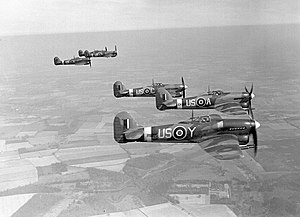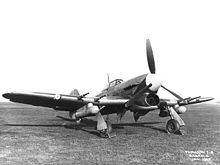Hawker Typhoon
| Hawker Typhoon | |
|---|---|
 Hawker Typhoon Mk IB of the 56th Squadron |
|
| Type: | Fighter bomber |
| Design country: | |
| Manufacturer: | |
| First flight: |
February 24, 1940 |
| Commissioning: |
1941 |
| Production time: |
1941 to 1945 |
| Number of pieces: |
3,330 |
The Hawker Typhoon was a fighter aircraft belonging to the British Hawker Siddeley Aircraft Co. It was used by the Royal Air Force (RAF) from 1941 during the Second World War . The machine, with its successor, Tempest, was one of the largest and heaviest fighter aircraft of its time. Because the Typhoon could not achieve the necessary flight performance for the intended task as an interceptor due to the "thick" wing profile above 6100 m (20,000 feet), it was finally used as a fighter-bomber . The single-engine and single-seat machine was manufactured by the Gloster Aircraft Company, which was owned by Hawker Siddeley built.
history
At Hawker Aircraft , Typhoon development began in March 1937, under the direction of chief designer Sidney Camm, directly after that of the Hawker Hurricane . The specification F.18 / 37 from January 1938 was used as the basis. This envisaged a fighter based on the similarly designed Napier Saber (24-cylinder H engine ) or Rolls-Royce Vulture (24-cylinder X engine ), both of which had more than 2,000 hp .
Two designs, "R" and "N", were produced, with the R-type receiving the Rolls-Royce engine. The nose section of the aircraft was more rounded here and the machine received a round radiator. On the N-Type with the Saber engine, the radiator was placed under the engine. Both models were given a front fuselage in tubular space construction made of welded steel; the rear area was constructed in half-shell construction. The wing profile was much thicker than that of the Supermarine Spitfire .
R type
The R-Type, called the Hawker Tornado , flew in October 1939 and the RAF immediately ordered 1,000 units. Defects in the construction quickly became apparent; Noticeable compressibility effects occurred at high speeds . The climb performance did not come close to that of the Spitfire. The R-Type was therefore no longer an option as a replacement for the Spitfire in the role of interceptor.
N type
The N-Type, called Typhoon , made its maiden flight in February 1940. It was to be manufactured by the Gloster Aircraft Company . The RAF ordered large numbers; however, there were also defects in the N-type. Parts of the wing paneling came off due to engine vibrations. Both orders were then initially canceled. However, work on the types continued on a small scale; the aerodynamics were improved and a thinner wing profile was installed on a trial basis. At Hawker's initiative, radial engines of the Bristol Centaurus type were also installed on a trial basis .
Efforts to correct the problems have shown some success; a series of Hawker tornadoes was delivered in the spring of 1941 and proved its efficiency with a maximum speed of 685 km / h. At this time, however, Rolls-Royce stopped producing the unreliable and immature Vulture engines.
Therefore, Hawker concentrated on the manufacture of the Typhoon. The first series of Mk IA twelve Browning machine guns caliber .303 British (7.7 mm) was delivered in May 1941st The effect of the machine guns was too little and so the next series, the Mk IB, was equipped with four 20-mm automatic cannons of the Hispano Mk. II type.
As the successor to the Typhoon, Sidney Camm designed the similarly constructed Hawker Tempest . Her wing had a laminar profile ; it could be used as a fighter-bomber and as a fighter.
The total production of the Typhoon, manufactured exclusively by Gloster, was 3,330 machines.
commitment
After the Focke-Wulf Fw 190 , which was much faster than the Spitfire V, increasingly intervened in the aerial combat over England , the likewise very fast Typhoon was also sent into the aerial combat. After 150 machines had already been delivered, there were a number of crashes that were initially erroneously attributed to a failure of the rear fuselage structure. Further investigations showed, however, that the breaking away of the mass balance on the elevator led to its flutter, which caused overloading of the rear fuselage and the breakage of the transport connection between the fuselage parts. The error could be corrected by replacing a part that cost only a few shillings.
Nevertheless, the Typhoon could not prove itself either as an interceptor against the Focke-Wulf Fw 190 or as an escort fighter for the British bombers flying into northern France . Since the Spitfire IX, a sophisticated high-performance fighter, had meanwhile gone into series production, there was no longer any need for the Typhoon as a fighter aircraft.
However, there was a need for a powerful fighter-bomber. The machines were then used for deep attacks in northern France and in combat in Normandy . They accompanied the Allied troops through France and Belgium . For this they were also equipped with unguided rockets of the type RP-3 (Rocket Projectile 3 inch ).
Production numbers
The Typhoon was built by Hawker and Gloster in Great Britain.
| version | Hawker | Gloster | total |
|---|---|---|---|
| Mk Ia | 4th | 100 | 104 |
| Mk Ib | 11 | 3163 | 3174 |
| total | 15th | 3263 | 3278 |
| year | number |
|---|---|
| 1941 | 27 |
| 1942 | 687 |
| 1943 | 1134 |
| 1944 | 1164 |
| until July 31, 1945 | 266 |
| total | 3278 |
After July 1945, 40–50 Typhoon were delivered by Gloster.
Technical specifications
| Parameter | Data of the Hawker Typhoon Mk. IB |
|---|---|
| crew | 1 |
| length | 9.73 m |
| span | 12.67 m |
| height | 4.52 m |
| Wing area | 25.92 m² |
| Empty mass | 3,990 kg |
| Max. Takeoff mass | 6,340 kg |
| drive | a 24-cylinder H-engine Napier Saber with 1,626 kW (2,212 PS) |
| Top speed | 663 km / h |
| Service ceiling | 10,350 m |
| Max. Range | 1,570 km |
| Armament | four 20 mm Hispano Mk. II automatic cannons , two bombs with a mass of 500 lb (227 kg) or 1,000 lb (454 kg) each, or eight RP-3 rockets |
Users
User states
Station locations in Germany

-
2. Tactical Air Force (2 TAF) / British Air Force of Occupation (BAFO)
- B. 111 / Ahlhorn , April to June 1945, Typhoon 1B ( 193rd , 197th , 263rd and 266th Squadron )
- B.105 / Drope , April to June 1945, Typhoon 1B ( 266th Squadron )
- R.16 / Hildesheim , June to August 1945, Typhoon 1B ( 193rd , 197th , 263rd and 266th Squadron )
- B. 150 / Hustedt , April to June 1945, Typhoon 1B ( 175th , 184th and 245th Squadron )
- B. 158 / Lübeck , May to September 1945, Typhoon 1B ( 137th , 174th and 247th Squadron )
- B.103 / Plantlünne , April to May 1945, Typhoon 1B ( 198th and 609th Squadron )
- B. 164 / Schleswigland , May to September 1945, Typhoon 1B ( 175th , 184th and 245th Squadron )
- B.116 / Wunstorf , May to September 1945, Typhoon 1B ( 198th and 609th Squadron )
Airfields that were occupied by the 137th, 175th and 247th squadrons exclusively during the war are not listed; From the end of March 1945 until the end of the war they still used B.100 / Goch , B.110 / Achmer , B.112 / Hopsten , B.120 / Langenhagen , B.156 / Lüneburg and B.118 / Celle .
Preserved machines
A Hawker Typhoon is in the Memorial de la Paix in Caen / France (see photo), the Royal Air Force Museum in Hendon also has a copy.
See also
Web links
Individual evidence
- ^ Francis K. Mason: Hawker Aircraft since 1920. 3rd, revised edition. Putnam, London 1991, ISBN 0-85177-839-9 , p. 322.
- ↑ a b National Archives, Kew, stock AVIA 10/311.




